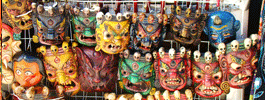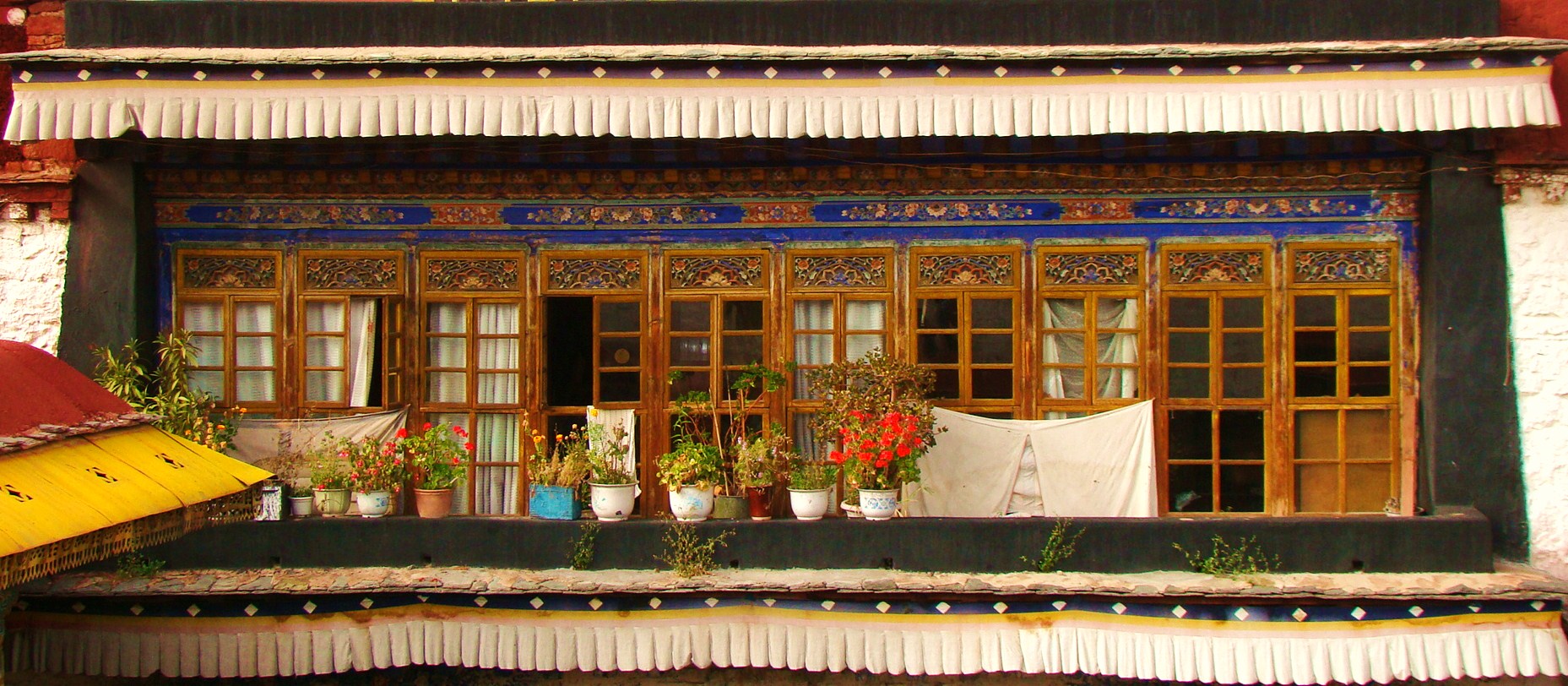| |
|
| |
|
|
BARKHOR RING |
|
Like
being on a Hollywood movie set, the Barkhor ring in the
center of the Tibetan old town will knock your socks off. From the
tinkling copper pots and glittering silver beads hanging from
hundreds of tiny street stalls, to the soothing drone of hundreds of
lips pursed in prayer, to the colorful costumes of this fascinating
populace, to the smell of the incense burning to "clean" the air,
there isn't another place on earth this enchanting.
 Given
enough time in Lhasa, after the sights are checked off, you'll find
the best thing of all is sitting on the curb with some tired
pilgrims and snapping photographs of the passing worshippers
twirling their prayer wheels and counting their prayer beads. This
is about as exotic a place as you're going to find, but for the
Tibetans it's simply their life, their way. And once you've spent a
bit of time, you'll understand why every visitor to Lhasa feels the
spirit of this place deep in their bones. It's a life-changing
experience, maybe the best place you've ever been or ever will go,
not only for the stunning esoteric majesty, but because of the
effect it can have on a western life. It's not Hollywood, although
the costumes and colors are reminiscent of some of the best sets of
all time. It's not fake, it's not a show for tourists, it's the
culture of the ages, the one culture who clings to their
7000-year-old roots, their customs and their religion no matter how
many obstacles block their path. This is Tibet...while it lasts. Given
enough time in Lhasa, after the sights are checked off, you'll find
the best thing of all is sitting on the curb with some tired
pilgrims and snapping photographs of the passing worshippers
twirling their prayer wheels and counting their prayer beads. This
is about as exotic a place as you're going to find, but for the
Tibetans it's simply their life, their way. And once you've spent a
bit of time, you'll understand why every visitor to Lhasa feels the
spirit of this place deep in their bones. It's a life-changing
experience, maybe the best place you've ever been or ever will go,
not only for the stunning esoteric majesty, but because of the
effect it can have on a western life. It's not Hollywood, although
the costumes and colors are reminiscent of some of the best sets of
all time. It's not fake, it's not a show for tourists, it's the
culture of the ages, the one culture who clings to their
7000-year-old roots, their customs and their religion no matter how
many obstacles block their path. This is Tibet...while it lasts.
|
| |
|
| |
|
|
JOKHANG TEMPLE |
|
Included
on UNESCO's World Heritage list in 2000 as part of the
Potala Palace, the Jokhang Temple is found in the Barkhor
ring facing the Potala Palace. With hundreds of worshippers
circling the temple (doing a kora around the temple)
everyday, dozens come to prostrate themselves in front of
the temple.
 There
is no particular number of prostrations necessary, but some
do as few as three or seven, while others stay for hours
doing up to a thousand prostrations a day (this, they do to
honor the gods and gain a better life, both this one and the
next, and to pray for world peace and happiness). Even tiny
children are being taught how to pray and prostrate on
colorful mats. Monks in colorful reds and golds roam in and
out of the temple while tourists snap their amazing shots
with trembling fingers. With an area of six acres, the
Jokhang Temple is the ultimate pilgrimage destination for
Tibetan Pilgrims and other Tibetan Buddhist practitioners. There
is no particular number of prostrations necessary, but some
do as few as three or seven, while others stay for hours
doing up to a thousand prostrations a day (this, they do to
honor the gods and gain a better life, both this one and the
next, and to pray for world peace and happiness). Even tiny
children are being taught how to pray and prostrate on
colorful mats. Monks in colorful reds and golds roam in and
out of the temple while tourists snap their amazing shots
with trembling fingers. With an area of six acres, the
Jokhang Temple is the ultimate pilgrimage destination for
Tibetan Pilgrims and other Tibetan Buddhist practitioners.
This four-story timber
complex has a very mysterious interior, a series of dozens
of prayer chapels and pilgrims lined up with hot yak butter
thermoses to fill flickering butter lamps, money bills to
offer the gods, and Hadas, long silken scarfs to drape
around the necks of deities. This procession can only be
seen in the morning session and if you really want to
"experience" the phenomenon, rather than just "look" upon
it, the three hours from 9am-noon is barely adequate. Check
out the statues of King Gampo and his Napalese and Chinese
wives on the second floor. Just to study the murals on these
7th century walls could take hours. Many people return to
the Jokhang Temple several times. To participate and get the
feel of their ferver, take some small change bills and a
couple of Hada scarfs (buy in Barkhor, very inexpensive),
but leave the butter to the pilgrims☺
 The
rooftop may be one of the most interesting places of all for
the avid photographer. The golden spires and peaks, the
yak-hair covered poles, the Dharma Wheel (chakra) flanked by
two deer (represents Sakyamuni/Buddha), the balcony where
the Dalai Lama once blessed crowds, even the traditional
Tibetan roofers who sing while they tap their feet to make
repairs - captivating! Maybe best of all is the breathtaking
view of the Potala Palace, flanked and backed by moss green
mountains, carved in shadows and capped by an ever-variable
display of the fluffiest clouds on earth. The
rooftop may be one of the most interesting places of all for
the avid photographer. The golden spires and peaks, the
yak-hair covered poles, the Dharma Wheel (chakra) flanked by
two deer (represents Sakyamuni/Buddha), the balcony where
the Dalai Lama once blessed crowds, even the traditional
Tibetan roofers who sing while they tap their feet to make
repairs - captivating! Maybe best of all is the breathtaking
view of the Potala Palace, flanked and backed by moss green
mountains, carved in shadows and capped by an ever-variable
display of the fluffiest clouds on earth. |
 |
|
|
